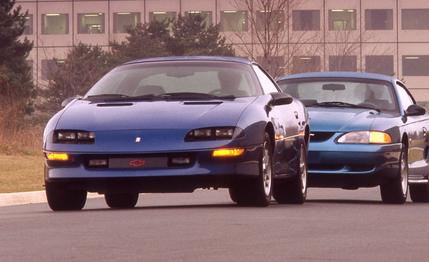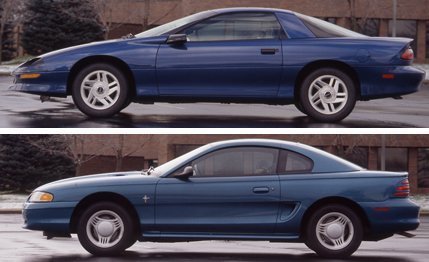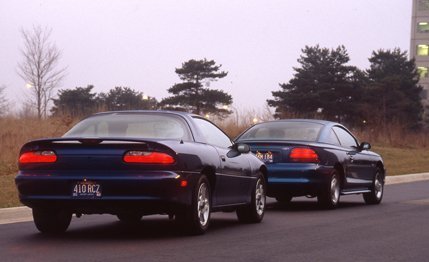
 Archived Comparison
Archived Comparison
Ford and Chevy have new cars carrying the celebrated Mustang and Camaro badges for 1994, and we've all had time to get a good look at them. By now, sides have been taken, with Ford fans squaring off against the Chevy crowds in bars right across the country. Meanwhile, prospective owners have been toting up numbers in their checkbooks, figuring out how to get their hands on one of these two-door chargers.


The easy way is to forego the V-8 power in these cars, settle for the V-6 that is offered in the base versions, and keep the change (you'll save about $3500 in the case of the Camaro, and nearly four grand with the Mustang). And that's not an entirely weird idea. In fact, according to the sales strategists in both companies, about half the buyers of these cars will do just that.
Although these are sporty cars that have carried an affordable high-performance image from generation to generation, there are many people for whom the style of these cars is the most important ingredient. Remember too that the base cars cost a lot less to insure. (The Z28 Camaro, much loved by thieves, zings drivers with a premium about 40-percent higher than for the base model. The Mustang GT, apparently ripped off less regularly, gets "only" a 25-percent high-performance surcharge.)


If you're really counting the pennies, the fact that the base cars have better fuel economy may enter your personal equation. The Camaro Z28 is rated at 17/26 city/highway mpg, while the base car gets 19/28. The Mustang GT gets 17/25 mpg and the base model gets 20/30 mpg. Also compelling are the more comfortable suspension settings found on the base cars.
Maybe, but none of the power-mongers here on Hogback Road would seriously consider the purchase of a new Mustang or Camaro without the V-8 engine option. The heart of a pony car, we declare, is the V-8. And because you have to accept lesser amounts of space and utility when you strap into one of these quintessential American muscle cars, perhaps you have a right to expect the gutsy V-8 sound and performance as recompense.
On the other hand, there are no other V-6—powered sporty cars on the market at this price level. The Probe GT starts at $16,375—and that's without an air conditioner. Even four-cylinder competitors such as Honda's Prelude or the Acura Integra cost $2000 to $5000 more. At which point, the V-8 versions of the Camaro and Mustang leap back into the picture. With this kind of pricing advantage, it's a real pity that our two contestants do not have particularly smooth and sophisticated powertrains to seal the deal.


But if we accept that compromise as part of a very persuasive bottom line, then the cars' historical rivalry and legions of supporters cry out for this contest. Also, despite the Camaro Z28's clear-cut triumph in the V-8 version of this perennial standoff, the six-cylinder title was no foregone conclusion. In fact, the Mustang V-6 came into this test looking good. Its larger-displacement engine (3.8 versus Chevy's 3.4 liters) promised better performance and possibly higher levels of refinement.
We knew also that Ford had produced notable reductions in noise, vibration, and harshness in its new Mustang, and we further anticipated that the stiff, quiet structure might work extremely well in concert with the smaller engine and the milder suspension settings. The outcome, as you will see, was close.